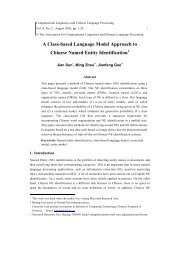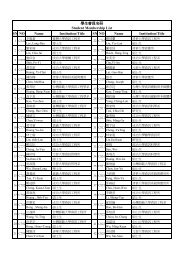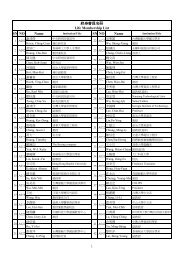Machine Translation Approaches and Survey for Indian ... - aclclp
Machine Translation Approaches and Survey for Indian ... - aclclp
Machine Translation Approaches and Survey for Indian ... - aclclp
You also want an ePaper? Increase the reach of your titles
YUMPU automatically turns print PDFs into web optimized ePapers that Google loves.
<strong>Machine</strong> <strong>Translation</strong> <strong>Approaches</strong> <strong>and</strong> <strong>Survey</strong> <strong>for</strong> <strong>Indian</strong> Languages 75Sr.NoMT System (Year)41 Phrase based English -Tamil MT (2011)Source-TargetLanguageEnglish - TamilDeveloper Approach DomainCEN, AMRITAUniversity, CoimbatorePhrase basedGeneral42 Sentence SimplificationSystem <strong>for</strong> English toTamil (2011)English - Tamil Not-Available Rule-based Not-Available43 Manipuri-EnglishBidirectional MT(2010)Manipuri-English <strong>and</strong>-English-ManipuriThoudamDoren Singh<strong>and</strong>SivajiB<strong>and</strong>yopadhyayStatisticalnews44 English to DravidianLanguage MT (2010)English to MalayalamCEN, AMRITAUniversity, CoimbatoreSMT BasedSimplesentences45 Anuvadaksh English to six other<strong>Indian</strong> languages i.e.Hindi, Urdu, Oriya,Bangla, Marathi, TamilEILMT consortiumhybridapproachTourism46 Google Translate <strong>Translation</strong>s between57 different languagesGoogle SMT General47 English to AssameseMTEnglish to Assamese Not-Available Rule-based Not-Available48 Russian-Tamil MT(1983-1984)Russian-TamilTamil University,TanjoreNot-Availablescientifictext49 Tamil - Malayalam MT Tamil - Malayalam BharathidasanUniversity, Tamil Nadu5. ConclusionNot-AvailableNot-AvailableThis survey described machine translation (MT) techniques in a longitudinal <strong>and</strong> latitudinalway with an emphasis on the MT development <strong>for</strong> <strong>Indian</strong> languages. Additionally, we tried todescribe briefly the different existing approaches that have been used to develop MT systems.From the survey, we found that almost all existing <strong>Indian</strong> language MT projects are based on astatistical <strong>and</strong> hybrid approach. We also identified the following two reasons that most of thedeveloped MT systems <strong>for</strong> <strong>Indian</strong> languages have followed the statistical <strong>and</strong> hybrid approach.The first reason is, since <strong>Indian</strong> languages are morphologically rich in features <strong>and</strong>agglutinative in nature, rule-based approaches have failed in many situations <strong>for</strong> developingfull-fledged MT systems. Second the general benefits of statistical <strong>and</strong> hybrid approacheshave encouraged researchers to choose these approaches to develop MT systems <strong>for</strong> <strong>Indian</strong>languages.









